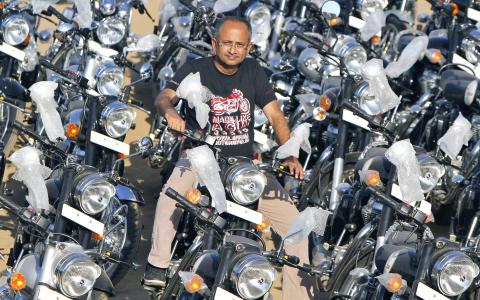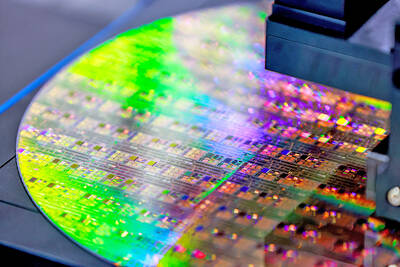The “thump” is gone, but sales are booming.
Royal Enfield Motors, a 119-year-old Anglo-Indian motorcycle maker with a cult following, has brought its distinctive bikes into the modern era with new and quieter engines and can’t make them fast enough to meet demand.
The once-sleepy company sold 74,600 motorcycles last year — a 40 percent increase — all made at its 57-year-old factory on India’s southeastern coast, and it is spending US$30 million this fiscal year in a push to double capacity and upgrade manufacturing technology.

Photo: Reuters
For now, customers must wait six to nine months to get their bikes.
“Paradoxically, the more we make, the more we appear to be falling behind. Only when the new plant kicks in fully next year will we be able to fully address the waiting periods,” Royal Enfield CEO Venki Padmanabhan said.
A new engine has replaced Royal Enfield’s antiquated cast-iron engine, boosting acceleration, performance, mileage and reliability, as well as reducing emissions.
The company is best known for the powerful Bullet model, but it is the newer Classic series that is driving growth in a crowded and fast-expanding Indian market where 10 million motorbikes were sold last year.
“They’ve finally got the markings, the logo and the color schemes perfect,” said 35-year-old George Koshy, who works in an advertising firm and owns four Royal Enfield bikes, including a Classic 500.
Royal Enfield’s motorcycles start at 108,000 rupees (US$2,100) in Mumbai and rise to 175,000 rupees, against 72,000 rupees for a 220cc Bajaj Avenger, a similarly powerful bike also marketed toward enthusiasts.
Harley Davidson, whose bikes start at 560,000 rupees, is part of a slew of overseas manufacturers such as Britain’s Triumph and Japan’s Kawasaki that is ramping up activity in India to capture a growing premium motorbike market.
“If you want to ride for the heart, you ride the Bullet; if you want to ride for performance, you ride the Harley,” said Koshy, who plans to add a Harley Davidson to his collection.
Purists still come to the company looking to buy a bike with the old engine, but they have to go to the second-hand market as production ceased in 2010.
Royal Enfield originally built motorcycles to be parachuted into enemy territory by British forces during World War II, and the classic styling and trademark thumping of its engine at full throttle drew a legion of gearheads to the brand, including TV host Jay Leno.
It rolled out its first motorized bike in 1901 and entered the Indian market in 1949, where the Bullet, now in its 80th year of manufacture, became a staple on the country’s roads.
Royal Enfield, which stopped building bikes in Britain in 1970 and was bought by India’s Eicher Motors in 1994, expects to open a new 20 hectares plant in the southern Indian state of Tamil Nadu next year, taking capacity to 150,000 vehicles.
It is a niche manufacturer in a country where mass-market players led by Hero MotoCorp and Bajaj Auto sell cheap bikes as basic transportation and family vehicles.
The company sold just 3,200 bikes overseas last year and is looking to expand its export markets on the strength of its upgraded engines. It recently signed up dealerships in Malaysia and the Philippines, and is working to resurrect its distribution network in Germany and France.
An auto-industry veteran, the 49-year-old Padmanabhan started his career with General Motors in Michigan and took the top job at Royal Enfield in January last year after two years as chief operating officer.
“For many motorcycle companies, when they change engines it’s like life and death — if you don’t do it right you’re finished,” he said.
“For us we think we’ve been successful with the UCE engine, which just happened a little over a year ago, and there’s still a lot more to be done with this engine,” he said.

The US government on Wednesday sanctioned more than two dozen companies in China, Turkey and the United Arab Emirates, including offshoots of a US chip firm, accusing the businesses of providing illicit support to Iran’s military or proxies. The US Department of Commerce included two subsidiaries of US-based chip distributor Arrow Electronics Inc (艾睿電子) on its so-called entity list published on the federal register for facilitating purchases by Iran’s proxies of US tech. Arrow spokesman John Hourigan said that the subsidiaries have been operating in full compliance with US export control regulations and his company is discussing with the US Bureau of

Taiwan’s rapidly aging population is fueling a sharp increase in homes occupied solely by elderly people, a trend that is reshaping the nation’s housing market and social fabric, real-estate brokers said yesterday. About 850,000 residences were occupied by elderly people in the first quarter, including 655,000 that housed only one resident, the Ministry of the Interior said. The figures have nearly doubled from a decade earlier, Great Home Realty Co (大家房屋) said, as people aged 65 and older now make up 20.8 percent of the population. “The so-called silver tsunami represents more than just a demographic shift — it could fundamentally redefine the

Taiwan’s foreign exchange reserves hit a record high at the end of last month, surpassing the US$600 billion mark for the first time, the central bank said yesterday. Last month, the country’s foreign exchange reserves rose US$5.51 billion from a month earlier to reach US$602.94 billion due to an increase in returns from the central bank’s portfolio management, the movement of other foreign currencies in the portfolio against the US dollar and the bank’s efforts to smooth the volatility of the New Taiwan dollar. Department of Foreign Exchange Director-General Eugene Tsai (蔡炯民)said a rate cut cycle launched by the US Federal Reserve

Businesses across the global semiconductor supply chain are bracing themselves for disruptions from an escalating trade war, after China imposed curbs on rare earth mineral exports and the US responded with additional tariffs and restrictions on software sales to the Asian nation. China’s restrictions, the most targeted move yet to limit supplies of rare earth materials, represent the first major attempt by Beijing to exercise long-arm jurisdiction over foreign companies to target the semiconductor industry, threatening to stall the chips powering the artificial intelligence (AI) boom. They prompted US President Donald Trump on Friday to announce that he would impose an additional